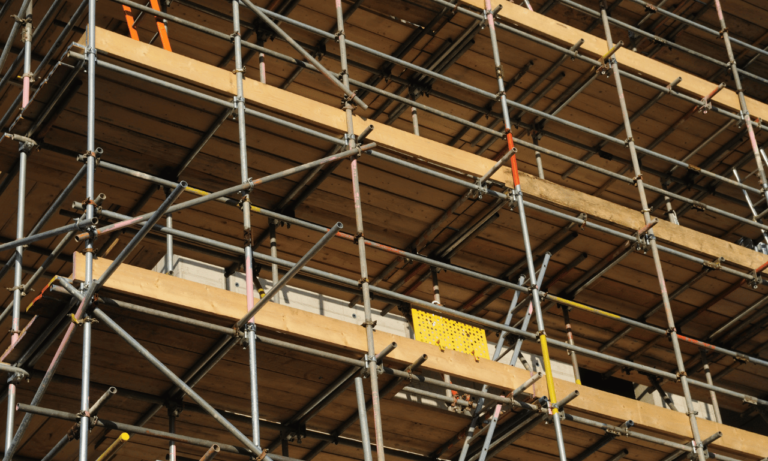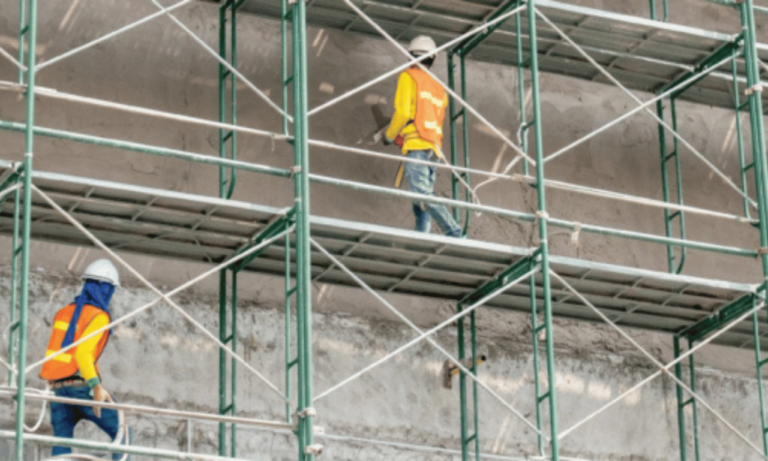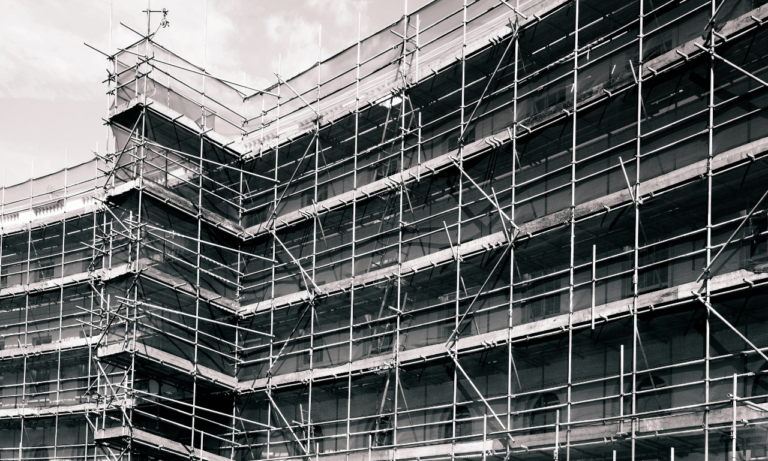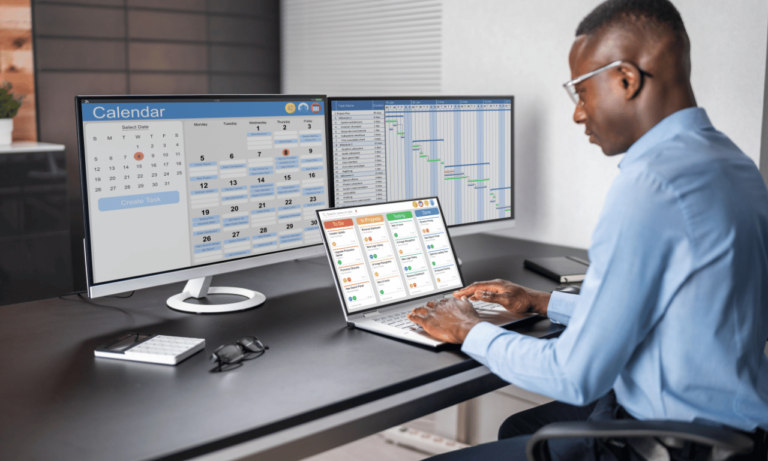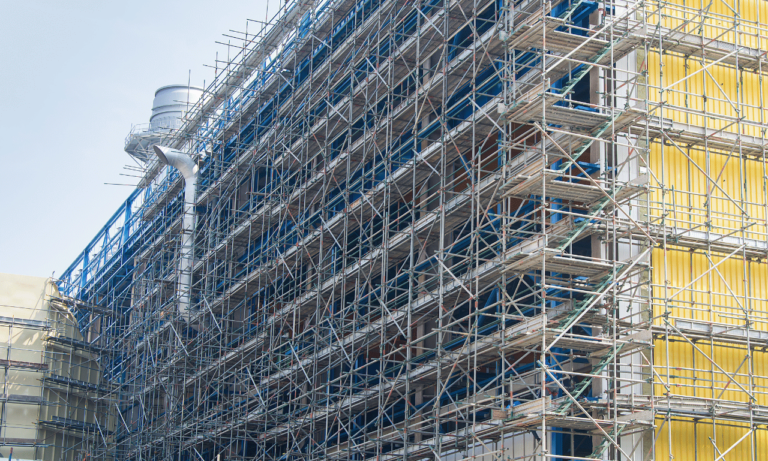Phone:
(+65)8319-0742
Safety is paramount when working at height, especially in the construction industry. One of the key elements in ensuring safety is proper roof scaffolding. With the use of reliable scaffolding equipment, workers can access elevated areas on rooftops safely and efficiently. Whether it’s for residential or commercial projects, having a robust scaffolding system is essential to prevent accidents and injuries.
Roof scaffolding serves as a temporary platform that provides stability and support for workers during roof construction or repair. It offers a secure working area, allowing tradespeople to perform their tasks with confidence. From installation to dismantling, following safety guidelines and using appropriate equipment is crucial to maintaining a hazard-free work environment.
By implementing essential safety tips and guidelines, workers can minimize risks associated with roof scaffolding and prioritize their well-being. This article will provide a comprehensive guide on roof scaffolding safety, including the importance of personal protective equipment (PPE), ensuring load-bearing capacities, compliance with regulations, thorough inspections, and good housekeeping practices.
Key Takeaways:
- Proper roof scaffolding is crucial for ensuring safety when working at height.
- Following safety guidelines and using appropriate equipment is essential for a hazard-free work environment.
- Personal protective equipment (PPE) plays a vital role in safeguarding workers.
- Understanding load-bearing capacities is necessary to maintain scaffold stability.
- Compliance with regulations and standards minimizes risks and liabilities.
Importance of Personal Protective Equipment (PPE) in Roof Scaffolding
When it comes to working at heights, personal protective equipment (PPE) plays a vital role in ensuring roof scaffolding safety. PPE refers to specialized gear and accessories designed to protect workers from potential hazards and minimize the risk of accidents.
One of the most crucial pieces of PPE in roof scaffolding is the use of hard hats. These helmets are essential for protecting workers from falling objects, such as tools or debris. In the event of an accident, a hard hat can prevent serious head injuries, providing a layer of protection for workers.
Eye protection is another vital component of PPE in roof scaffolding. Workers should wear safety goggles or glasses to shield their eyes from dust, debris, and any potential flying objects. Proper eye protection ensures that workers maintain clear vision, reducing the risk of accidents and eye injuries.
Hearing protection is also important when working in construction environments with loud noise, such as hammering or machinery. By wearing earplugs or earmuffs, workers can safeguard their hearing and prevent long-term damage.
In addition to head, eye, and hearing protection, workers should also wear gloves to protect their hands from cuts, scrapes, and punctures. Proper gloves provide a better grip on tools and materials, reducing the chance of accidents due to slips or dropped objects. Tool-tethering lanyards are also essential for preventing tool drops and ensuring worker safety.
Non-slip footwear is another critical aspect of PPE in roof scaffolding. These specialized shoes or boots have slip-resistant soles, reducing the risk of falls due to slippery surfaces. Workers can maintain stability and reduce the chances of accidents caused by loss of balance.
Lastly, fall arrest equipment is vital for workers’ safety when working at heights. Harnesses, lanyards, and anchor points help prevent serious injuries by providing a means of restraint or arrest in the event of falls. Fall arrest equipment should always be properly fitted, inspected, and used according to manufacturer guidelines.
| Personal Protective Equipment (PPE) | Benefits |
|---|---|
| Hard hats | Protection against falling objects |
| Eye protection | Shielding from debris and flying objects |
| Hearing protection | Preserving auditory health in noisy environments |
| Gloves | Hand protection and improved grip |
| Non-slip footwear | Preventing slips and falls |
| Fall arrest equipment | Minimizing the risk of serious injuries from falls |
By utilizing appropriate personal protective equipment (PPE), workers can ensure their safety and minimize the risk of accidents in roof scaffolding projects. PPE provides a crucial layer of defense against potential hazards, allowing workers to perform their tasks with confidence and peace of mind.
Ensuring Proper Load-Bearing Capacities in Roof Scaffolding

When it comes to roof scaffolding, understanding load-bearing capacities is absolutely crucial for maintaining the safety of workers and the integrity of the structure. Exceeding the intended design capacity can lead to serious injuries and even scaffold failure, posing significant risks in construction projects.
Scaffold components are typically designed with a 4 to 1 safety factor, ensuring they can support a significant load without compromising stability. However, it is imperative to know the specific load capacity of the scaffold structure in order to prevent accidents and ensure worker safety.
Before placing concentrated loads on the scaffolding decks, it is essential to adhere to load-bearing capacity guidelines. This involves carefully assessing the weight limits and restrictions of the scaffolding system, considering factors such as the materials being used and the overall design and configuration of the structure.
By closely following load-bearing capacity guidelines, construction professionals can ensure that the scaffolding can withstand the expected loads without compromising the safety of workers and the surrounding environment. This promotes a secure and stable working platform for employees, reducing the risk of accidents and injuries in roof scaffolding projects.
Load-Bearing Capacities for Common Scaffold Structures
| Scaffold Structure | Load Capacity (lbs) |
|---|---|
| Single Scaffold Tube | 2,500 |
| Double Scaffold Tube | 3,300 |
| Cantilever Scaffold | 4,000 |
| Support Scaffold Tower | 5,000 |
| Birdcage Scaffold | 6,000 |
It is important to note that the load-bearing capacities may vary depending on the specific design, materials, and manufacturer recommendations. It is always recommended to consult the scaffold’s manufacturer or a qualified engineer to determine the precise load limits for a particular scaffolding system.
By prioritizing load-bearing capacities and ensuring that all loads on the scaffolding system remain within the prescribed limits, construction professionals can create a safe and secure environment for workers while minimizing the risk of accidents and scaffold failure.
Compliance with Regulations and Standards for Roof Scaffolding

When it comes to roof scaffolding, compliance with regulations and standards is of utmost importance. These regulations are typically governed by Federal OSHA, established to ensure the safety of workers in different industries. It is crucial to research and understand the specific requirements of OSHA, industry standards, and customer site requirements before constructing any scaffolding platforms.
By adhering to scaffolding regulations and standards, you can significantly reduce the risk of accidents, employee hazards, and potential liabilities. Compliance ensures a safe work environment where workers can carry out their tasks without undue risks to their well-being.
One important aspect of compliance is the requirement for a Competent Person inspection, mandated by OSHA. A Competent Person is responsible for inspecting scaffold platforms and ensuring their safety and stability. This includes identifying and addressing any potential risks and hazards associated with scaffold use.
Furthermore, scaffold users should receive proper training to recognize and minimize risks. This training equips workers with the knowledge and skills necessary to safely navigate and utilize scaffolding systems, reducing the likelihood of accidents or injuries.
OSHA Requirements for Roof Scaffolding Compliance
OSHA has set specific requirements to ensure the safe use of scaffolding in various industries. These requirements include:
- Regular inspections of scaffolding systems by a Competent Person to identify and address any hazards.
- Training programs for scaffold users to ensure they are knowledgeable about safety procedures and protocols.
- Clear guidelines on load-bearing capacities to prevent structural failures and accidents.
- Maintaining proper documentation of inspections, training, and any modifications made to the scaffolding system.
By complying with OSHA requirements and industry standards, you can demonstrate your commitment to safety and protect both your workers and your business from potential risks and legal consequences.
Ensuring Compliance: Key Considerations
To ensure full compliance with scaffolding regulations and standards, consider the following:
- Stay updated on the latest OSHA regulations and industry standards related to roof scaffolding safety.
- Thoroughly assess customer site requirements to ensure scaffolding construction aligns with specific needs and regulations.
- Implement regular Competent Person inspections to identify and mitigate potential hazards.
- Maintain accurate documentation of inspections, training, and modifications to scaffold systems.
- Provide comprehensive training to scaffold users to enhance their knowledge of safety protocols and minimize risks.
By prioritizing compliance with regulations and standards, you can create a safer work environment, prevent accidents, and enhance the overall efficiency of roof scaffolding operations.
Thorough Inspections and Maintenance for Roof Scaffolding

Before setting up roof scaffolding, it is crucial to conduct thorough inspections of all materials to ensure structural integrity. By inspecting for defects, mismatching components, and ensuring proper installation of scaffolding parts, you can effectively prevent accidents and avoid structural failure.
Regular inspections and maintenance of scaffolding structures are essential for ongoing safety. This includes checking for hazards, defects, and debris, as well as ensuring cleanliness. A clean and well-maintained scaffold not only promotes safety but also improves the overall efficiency of the construction project.
It is important to monitor weather conditions when working with roof scaffolding. Adverse weather such as high winds, heavy rain, lightning, snow, and ice can pose significant risks to scaffold safety. Therefore, regular weather condition assessments are necessary to ensure the safety of workers and prevent accidents caused by unpredictable weather events.
To summarize, meticulous inspections and regular maintenance promote a hazard-free work environment and minimize the risks associated with roof scaffolding. By keeping a close eye on the structural integrity of the scaffold, ensuring cleanliness, and monitoring weather conditions, you can enhance the overall safety of the construction site.
Thorough Inspections and Maintenance Checklist
| Inspection Area | Checkpoints |
|---|---|
| Scaffold Stability | Check for any signs of swaying or instability. |
| Defect Inspection | Inspect scaffold components for any defects, cracks, or damage. |
| Mismatching Components | Ensure all components are compatible and do not pose any risks due to mismatching. |
| Proper Installation | Verify that all scaffolding parts are correctly assembled and securely fastened. |
| Scaffold Cleanliness | Clean the scaffolding regularly, removing debris and ensuring a tidy work environment. |
| Weather Conditions | Monitor weather forecasts and assess whether it’s safe to work on the scaffold. |
Conclusion
Roof scaffolding safety is of utmost importance in the construction industry. By following essential safety tips and guidelines, using personal protective equipment (PPE), ensuring proper load-bearing capacities, complying with regulations and standards, conducting thorough inspections, and practicing good housekeeping, accidents and injuries in roof scaffolding projects can be minimized.
Maintaining a safe work environment requires vigilant adherence to safety practices and continuous training and education for workers. With the right precautions, roof scaffolding can be a secure and effective solution for accessing elevated areas in construction projects. By prioritizing safety, construction companies can mitigate risks, protect their workers, and maintain a positive track record in terms of safety performance.
As the construction industry continues to evolve, it is crucial for employers and employees to stay updated on the latest safety protocols and regulations. Ongoing training and education can enhance knowledge and awareness, ensuring that everyone involved in roof scaffolding projects is equipped to follow best practices and make informed decisions that prioritize safety.
FAQ
Why is roof scaffolding important for construction projects?
Roof scaffolding provides a safe and secure platform for workers to access elevated areas during construction projects. It ensures the stability and integrity of the structure and reduces the risk of accidents and injuries.
What personal protective equipment (PPE) should be used in roof scaffolding?
When working on roof scaffolding, it is essential to wear hard hats to protect against falling objects, use non-slip footwear to prevent slips and falls, and utilize proper fall arrest equipment to prevent serious injuries. Hand-protecting gloves and tool-tethering lanyards also enhance safety.
How important is understanding load-bearing capacities in roof scaffolding?
Understanding the load-bearing capacities of the scaffolding structure is crucial to prevent overloading and scaffold failure. It is necessary to know the specific load capacity of the scaffold before placing concentrated loads on the decks.
What regulations and standards should be followed for roof scaffolding?
Scaffolding regulations are generally governed by Federal OSHA, which sets guidelines for different industry classifications. It is crucial to research and understand the specific requirements of OSHA, industry standards, and customer site requirements before constructing any scaffolding platforms.
How should roof scaffolding be inspected and maintained?
Thorough inspections of all roof scaffolding materials should be conducted to ensure structural integrity. Regular inspections and maintenance, including checking for defects, hazards, and cleanliness, are essential for ongoing safety. Monitoring weather conditions is also important, as adverse weather can pose significant risks to scaffold safety.
What is the importance of roof scaffolding safety?
Roof scaffolding safety is of utmost importance in the construction industry. By following essential safety tips and guidelines, using personal protective equipment (PPE), ensuring proper load-bearing capacities, complying with regulations and standards, conducting thorough inspections, and practicing good housekeeping, accidents and injuries in roof scaffolding projects can be minimized.


